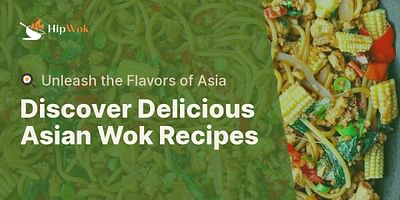Katlyn Considine is a passionate food enthusiast and skilled home cook who developed a deep admiration for wok cooking during her extensive travels throughout Asia. She delights in experimenting with a variety of ingredients and culinary techniques, and takes great pleasure in imparting her knowledge and exciting discoveries to her devoted readers.
Embarking on your culinary journey through the vast expanse of Chinese cuisine can be an exhilarating adventure. As we navigate through the myriad of flavors and techniques, it's essential to understand the language of Chinese cooking. Here, we'll explore some of the most commonly used Chinese culinary terms, food terms, and cooking vocabulary, which can help you better understand and appreciate the art of wok cooking.
Cracking the Code: Your Guide to Chinese Cooking Terms 🥡
Understanding Chinese kitchen words is like decoding the secret language of a recipe. It allows you to understand the method, technique, and the intended result of the dish. Here are some fundamental terms:
Essential Chinese Cooking Vocabulary
- 炒 (Chǎo): Stir-fry
- 煮 (Zhǔ): Boil
- 蒸 (Zhēng): Steam
- 烤 (Kǎo): Roast
- 炸 (Zhá): Deep-fry
- 煎 (Jiān): Pan-fry
- 焖 (Mèn): Stew
- 炖 (Dùn): Simmer
- 拌 (Bàn): Mix
- 爆 (Bào): Explode, used to describe the quick frying of garlic, ginger or chili in hot oil to release their flavors
Describing Flavors and Textures
- 酸 (Suān): Sour
- 甜 (Tián): Sweet
- 苦 (Kǔ): Bitter
- 辣 (Là): Spicy
- 咸 (Xián): Salty
- 鲜 (Xiān): Umami or savory
- 香 (Xiāng): Fragrant
- 脆 (Cuì): Crispy
- 爽 (Shuǎng): Refreshing
- 软 (Ruǎn): Soft
Key Ingredients in Chinese Cooking
- 大葱 (Dà cōng): Spring onion
- 姜 (Jiāng): Ginger
- 蒜 (Suàn): Garlic
- 酱油 (Jiàng yóu): Soy sauce
- 生抽 (Shēng chōu): Light soy sauce
- 老抽 (Lǎo chōu): Dark soy sauce
- 米醋 (Mǐ cù): Rice vinegar
- 料酒 (Liào jiǔ): Chinese cooking wine
- 豆瓣酱 (Dòu bàn jiàng): Broad bean paste
- 花椒 (Huā jiāo): Sichuan peppercorn
Taste the Rainbow: Unpacking Chinese Food Descriptions 🌈
Asian food description words often revolve around the taste, texture, and aroma of dishes. Here are some terms that can help you describe your culinary creations:
Describing Flavors and Textures
- 酸 (Suān): Sour, a taste that can awaken your senses and add a refreshing twist to your dishes.
- 甜 (Tián): Sweet, the delightful taste that can bring a smile to your face and balance the heat in your food.
- 苦 (Kǔ): Bitter, a complex flavor that can add depth and sophistication to your culinary creations.
- 辣 (Là): Spicy, the fiery sensation that can ignite your palate and invigorate your dishes.
- 咸 (Xián): Salty, a fundamental taste that can enhance the flavors of your ingredients and bring harmony to your meals.
- 鲜 (Xiān): Umami or savory, the rich and satisfying taste that can elevate your dishes to a whole new level.
- 香 (Xiāng): Fragrant, the enticing aroma that can draw you into a dish and make your mouth water.
- 脆 (Cuì): Crispy, a texture that can add a delightful crunch to your food and make every bite exciting.
- 爽 (Shuǎng): Refreshing, a characteristic that can cleanse your palate and make your dishes feel light and invigorating.
- 软 (Ruǎn): Soft, a texture that can make your dishes comforting and pleasing to the palate.
The Backbone of Flavor: Must-Know Chinese Kitchen Words 🍲
There are some key ingredients that form the backbone of Chinese cuisine. Familiarizing yourself with these will give you a solid foundation in the wok recipe language.
Key Ingredients in Chinese Cooking
- 大葱 (Dà cōng): Spring onion. A staple in many Chinese dishes, providing a subtle, sweet flavor and a crisp texture.
- 姜 (Jiāng): Ginger. Its unique, spicy flavor is essential in creating the depth of taste in Chinese cuisine.
- 蒜 (Suàn): Garlic. A universal flavor enhancer, its pungent, spicy taste mellows and sweetens considerably with cooking.
- 酱油 (Jiàng yóu): Soy sauce. Used for its salty flavor and dark color in stir-fry, marinades, and more.
- 生抽 (Shēng chōu): Light soy sauce. It's saltier, thinner, and lighter in color than dark soy sauce, often used for seasoning and not coloring.
- 老抽 (Lǎo chōu): Dark soy sauce. It's less salty, thicker, and darker, used primarily for adding color to dishes.
- 米醋 (Mǐ cù): Rice vinegar. Its mild, slightly sweet flavor is used in a variety of dishes, from pickles to stir-fries.
- 料酒 (Liào jiǔ): Chinese cooking wine. It adds depth and richness to dishes, enhancing the flavors of other ingredients.
- 豆瓣酱 (Dòu bàn jiàng): Broad bean paste. A spicy, salty paste made from fermented broad beans, it's the soul of Sichuan cuisine.
- 花椒 (Huā jiāo): Sichuan peppercorn. Known for its unique aroma and flavor, it creates a tingly numbness in the mouth.
From Wok to Plate: Decoding Chinese Dish Descriptions 🍽️
Finally, it's time to apply these terms to actual dishes. Here are some popular Chinese dishes and their descriptions. This is where the magic of Chinese cooking vocabulary truly comes alive!
Let's dive deeper into the meaning and descriptions of these popular Chinese dishes:
As you continue your culinary journey, remember to be adventurous and open-minded. Embrace the complexity of flavors and techniques in Chinese cuisine!
While using these Chinese culinary terms in your cooking journey, remember to be adventurous and open-minded. After all, the beauty of Chinese cuisine lies in its diversity and the unique stories each dish tells. Happy wok cooking!
If you're interested in learning more about cooking Chinese dishes, you might find it helpful to check out these simple Asian dishes that can be made using a wok or these easy and affordable Asian-inspired recipes.















